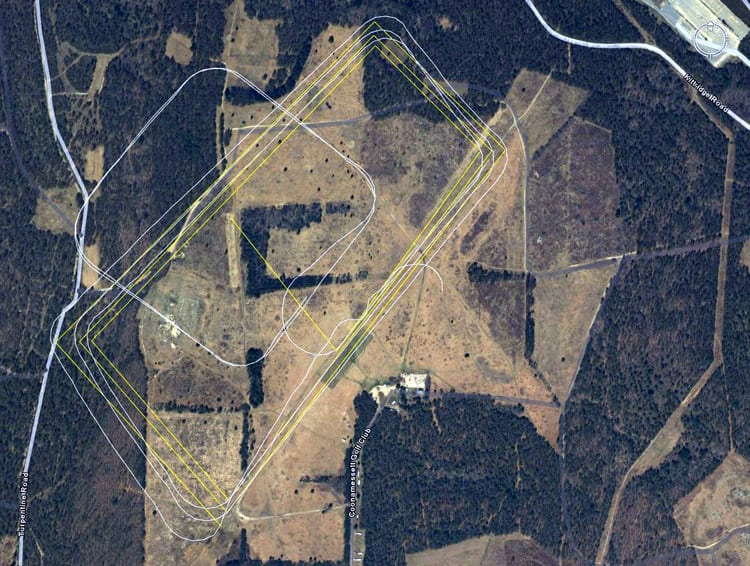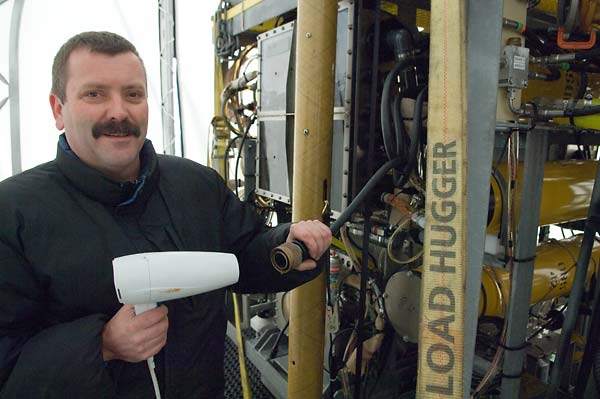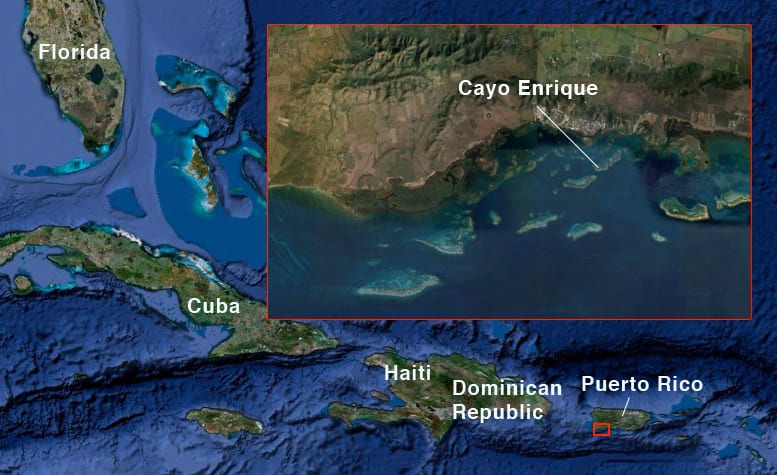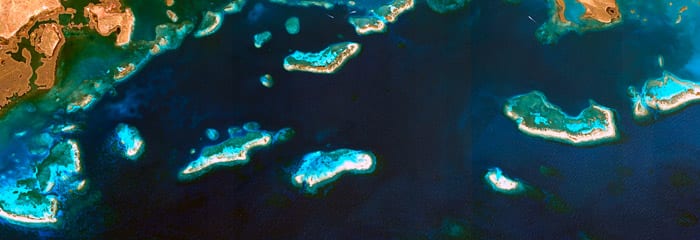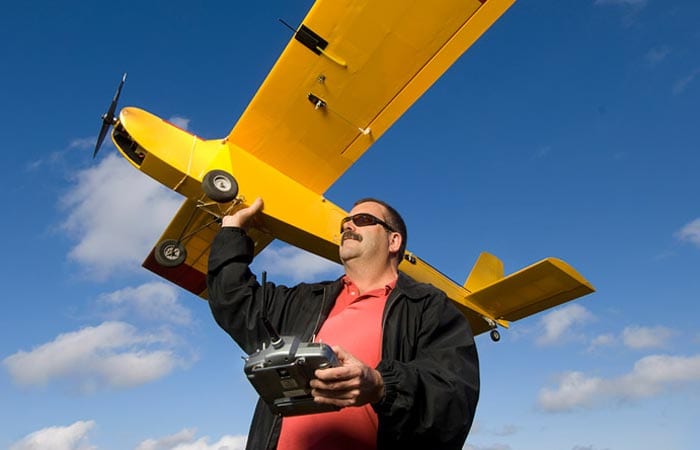
Turning a Toy into a Scientific Tool
Engineer exploits model airplane hobby to invent flying research camera
John Bailey spends most sunny weekends on a grassy field behind a movie theater on Cape Cod with a group of model airplane enthusiasts and their handmade creations. The hobbyists, fueled on passion and take-out pizza, spend hours with their eyes on the sky, manipulating their remote-controlled planes to dive and soar in the air.
Until last year, Bailey’s hobby was solely an outlet for relaxation and entertainment, after weekdays spent building underwater research vehicles—designed to dive and soar in the sea—for Woods Hole Oceanographic Institution (WHOI). Then one of Bailey’s colleagues approached him to bring his hobby to the job.
Hanumant Singh, a fellow engineer at WHOI, had been looking for an inexpensive way to gather aerial images to learn how huge Arctic Ocean ice floes are melting. He also wanted to get a birds’ eye view of the often devastating impacts of hurricanes and other storms on coral reefs.
Methods existed to gather this information, but they all had limitations. Satellite images can’t show enough close-up details. Buoys in and around ice floes don’t provide comprehensive views.
Airplanes flown by pilots cost too much—up to $100,000 per mission—to use routinely. Neither satellites nor piloted planes can be dispatched to capture crucial images in the hours immediately after a storm. Underwater vehicles also weren’t cheap and took longer to cover large areas, and they couldn’t work reliably around moving ice floes or above shallow reefs just a few feet beneath the ocean surface.
Singh reasoned that a low-flying, remote-controlled model airplane fitted with a digital camera in its hollow belly could provide just the views he needed of the tops of melting Arctic ice floes, as well as the breadth of storm damage to coral reefs in clear, shallow waters.
Moreover, instead of having to schedule an expensive plane and pilot far in advance, one person and the model plane could be dispatched, and at a moment’s notice, if necessary. Singh approached Bailey with the idea.
“I immediately knew it could work,” said Bailey, who has designed and built underwater robots with Singh since 2003. “I loved the idea of taking a model plane and making it useful for others in their work for the advancement of science.”
From the ice-covered Arctic to the turquoise Caribbean
Bailey spent the last year building, modifying, and testing a model plane dedicated to research. Sometime in the fall, Singh and Bailey will launch it over the ice from the deck of the icebreaker Arctic Sunriseas it sails through ice floes from the Arctic island of Svalbard through the Fram Strait, near northern Greenland.
They will be part of a team from the University of Cambridge looking at regional sea ice melting rates, specifically at pressure ridges, where ice buckles and piles up as the massive floes grind together. While instruments on buoys can provide measurements of ice melting in the sea, the plane will provide “the topside view of the ice,” Singh said.
Then the researchers will head south during the Atlantic’s stormiest season for the beaches of southwestern Puerto Rico, working with colleagues at the University of Puerto Rico. Their goal is to assess damage to a coral reef right after storms, which pummel the reefs each fall, overwhelming them with sand and sediments or washing shoreline pollution onto them. Then they will look at the reef in subsequent weeks to see if and how marine life recovers.
Tinker, fixer, soldier, researcher
Bailey began building model airplanes in 2004 for fun in his basement (which he and his wife refer to as “the man cave.”) He estimates that he has assembled about 50 model airplanes in the last five years from kits he orders from the Internet. Most of the time, he said, he throws out the accompanying instructions, grabs a cup of coffee or a beer, and lets his imagination guide the building of the planes. He keeps and flies his favorites; “I crash or sell those I don’t like,” he said.
His hobby, and perhaps his path to WHOI, started as a five-year-old boy. “We didn’t have garbage pick up, so I’d go with my dad to the local dump,” he said. There he found treasures, including the materials he needed to build his first working radio—when he was in first grade.
“At first my parents weren’t too crazy about me bringing stuff home from the dump,” he said. “Then they realized how useful my skills could be.”
In a corner of his suburban home, in Winchester, eight miles north of Boston, Bailey became the family mechanic. In second grade, when their television broke, he built a new one that he resurrected from the dump. In fourth grade, he installed touch-tone telephones on every floor of his three-story house, including the basement, to the delight of his two teenage sisters.
He also refurbished their hairdryers and stereos, including one that he went on to trade for his first car, a green and black 1967 Mercury Cougar. “I got an auto repair book and raided the local auto graveyard for inside door panels, fenders, and other parts,” he said.
He then moved on to repairing helicopters for the U.S. Marine Corps at an air station in New River, North Carolina. “Helicopters break all the time because they vibrate so much. So they were a great thing to learn from, since there was always something on them that needed repair,” he said.
His work at auto dealerships and an airplane mechanics shop in Hyannis led to employment at WHOI in 1991, first in the Geology and Geophysics Department working on ocean-bottom seismometers, and then with the Institution’s Deep Submergence Lab, which develops robots and vehicles for deep-sea exploration. In 2007, for example, he built, operated, and maintained a one-of-a-kind deep-sea camera and sampling vehicle nicknamed “Camper” to explore the bottom of the ice-covered Arctic Ocean.
“Model airplanes are such a natural extension of what I do for a living, and what I love to do in my free time, which is to use my hands to build. I could just kick myself for not getting into this sooner,” he said.
Building a one-of-a-kind plane
For the WHOI model plane, he assembled and glued the 12-pound, 8-foot balsa wood wings and 6-foot body. He then installed a battery-powered engine. Gas-powered engines are more powerful, but their tendency to vibrate would shake the plane and make the photographs fuzzy. “They also sound like a flying chainsaw,” Bailey said. “The electric motor allows us to work more discretely.”
Bailey modified the plane to create a secure space in a forward compartment to accommodate a 5-pound digital camera. Before each flight, the camera will be pre-programmed to take photos as the plane flies—for example, snapping a shot every 100 meters during a flight—depending on wind conditions and the plane’s speed.
He designed the plane so the tail section can be removed, making it easy to ship to different research locations. Even the plane’s color was a significant choice for the tasks it will face. The school-bus-yellow paint (common on buoys, deep-sea robots, and other oceanographic instruments) stands out against ice or blue or gray sky and water, making it easier for Bailey to fly and recover the plane.
Though the task of building the plane was straightforward, Bailey discovered early in the process a manufacturing glitch with the autopilot that, when engaged, “instantly caused the plane to go to full throttle and dive to the ground.” He became a beta tester for the manufacturer and helped iron out the glitch.
No bells and whistles
Singh estimates that the whole project cost about $10,000 and took about a year to complete and initially test—a fraction of the cost and time of most oceanographic instruments.
“You see a lot of souped-up model planes out there. This is a no-frills, lightweight system,” Bailey said. “We went this route for the low cost and to make it easy to work with for science.”
Boxy and unadorned, the plane is smaller and less sophisticated than unmanned remote-controlled airplanes used by meteorological researchers to probe hurricanes and storms. Singh likes the plane’s modest appearance: “That way if we crash, it’s not a total heartbreaking loss over the expense of it,” he said.
The Federal Aviation Authority requires that the researchers keep the plane at an altitude of 400 feet or less, and within their sight at all times, Bailey said. He expects that it will normally fly about 100 feet above ice or water.
The plane will cruise at about 70 kilometers (43 miles) per hour and will fly over Arctic ice and Caribbean coral reefs in a coordinated, back-and-forth pattern, which researchers often call “mowing the lawn.”
A squadron of scientific model planes?
During most of its missions, the plane will operate on autopilot, but Bailey will take control and bring the plane back to the ship or beach. When it returns to shore, researchers will remove the camera, download the images to a computer, and put together an overlapping series of hundreds of photos into a single, mosaic aerial map of the ice or reef.
“It’s an opportunity to see the big picture of an ecosystem,” Singh said. For example, in Puerto Rico, “we’d like to look where there is sand, where there is coral, and where there is sea grass. Then we’d like to figure out where coral bleaches,” or dies off as a result of storm-related stress.
“Then as time passes, we’ll fly the plane out over the reef again and make the same map,” Singh said. “The idea is to watch all of these features over time so we can see how they are changing, and figure out why.”
If all goes well in the Arctic and Puerto Rico, and if he can find funding, Singh said he envisions a squadron of camera-equipped model airplanes monitoring areas of the Earth for oceanographic purposes.
Though most oceanographic instruments head out to sea with a name, Singh said their first plane has yet to be christened.
“If you give us a half million dollars,” he said, only half-jokingly, “I would name it for you.”
Funding for the development of the model airplane came from the Center for Subsurface Sensing and Imaging Systems (CenSSIS), a multi-university National Science Foundation Engineering Research Center (NSF-ERC).
Slideshow
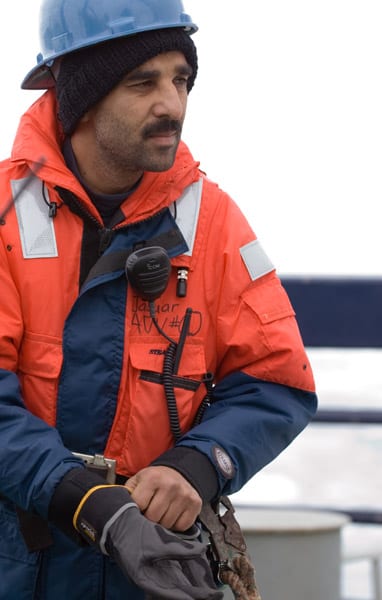
Slideshow
 Hanumant Singh, an engineer at WHOI, asked Bailey to build the model airplane. Singh had been looking for an inexpensive way to gather aerial images to learn how huge Arctic Ocean ice floes are melting. He also wanted to get a birds’ eye view of the often devastating impacts of hurricanes and other storms on coral reefs. “It’s an opportunity to see the big picture of an ecosystem,” Singh said. (Photo by Chris Linder, Woods Hole Oceanographic Institution)
Hanumant Singh, an engineer at WHOI, asked Bailey to build the model airplane. Singh had been looking for an inexpensive way to gather aerial images to learn how huge Arctic Ocean ice floes are melting. He also wanted to get a birds’ eye view of the often devastating impacts of hurricanes and other storms on coral reefs. “It’s an opportunity to see the big picture of an ecosystem,” Singh said. (Photo by Chris Linder, Woods Hole Oceanographic Institution)- The model airplane flies in a pre-programmed pattern over a specified area, taking photographs. In this test flight over a wildlife refuge on Cape Cod, the programmed flight is shown as the yellow line and the actual flight is the white line. (Google Maps, Courtesy of John Bailey)
- Growing up, Bailey learned about engineering by refurbishing his family's electronics, including his sisters' hair dryers. At WHOI, he took along his wife's hair dryer to warm rubber connectors on "Camper," a deep-sea robot he built for a 2007 research expedition to the Arctic.(Photo by Chris Linder, Woods Hole Oceanographic Institution)
- The model plane developed by Singh and Bailey will be used in the fall to photograph a coral reef called Cayo Enrique, located southwest of Puerto Rico. The researchers, in collaboration with colleague Roy Armstrong at the University of Puerto Rico, hope to photograph the reef before and after storms to see their impacts on the corals. (Google Maps)
- The model airplane, flying at an altitude of 100 feet, will be able to take detailed photos of the coral reef at Cayo Enrique. Unlike traditional higher-flying planes, it can be dispatched more easily and at a fraction of the cost. (Photo courtesy of Roy Armstrong, University of Puerto Rico)
Related Articles
- Waiting on the next freshwater flush
- Tracking change in the Arctic Ocean
- A ‘Ticking Time Bomb’ in the Arctic
- Communicating Under Sea Ice
- Signs of Big Change in the Arctic
- Ice, Wind & Fury
- Exploring the Arctic in the Midst of Change
- Reaching Up Into Perilous, Icy Waters
- Under-ice Floats Offer a ‘Breakthrough’
Featured Researchers
See Also
- John Bailey
- Hanu Singh's Lab at WHOI
- Arctic Voyage Tests New Robots for Ice-Covered Oceans from Oceanus magazine
- The Airplane that Studied the Ocean from Oceanus magazine

